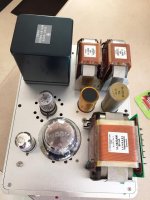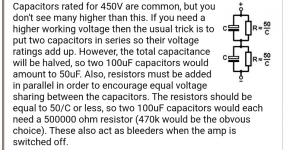I'm ready to order parts for a new build. I am complete noob, just did a good amount of reading/listening on the subject, I feel like I'm ready to jump in.
I am going to follow Walton Audio's schematic and build since there is a pretty detailed guide for it.


I do have a couple of questions:
1, I am from Europe, so I am having a hard time sourcing the 3 large capacitors on the PSU. Is there maybe a modern alternative to oil capacitors that is more available works well with this? Do I really need 600V there? Would something like these work? Tube-Town Store - JJ 250 mF @ 500 V
2, I am planning to use a power transformer which has an output of 400 VAC instead of the 380 on the drawing. Is that going to be fine or I have to adjust things?
3, Since the primary of this PT has a lot of options, I wanted to double check my plan to wire this for the 230V here in Montenegro.

So for 230V, I connect the 120V BLU to the live wire, 110V BLK/RED to the neutral, cur short and tie the 0V BRN and 120V BLK together. Do I connect the SH GREY to the main earth screw?
4, This PT has pretty short heater wires, so I will definitely need to extend some of them. What's the best way to do that? I know I should twist them together very tight.
Thank you very much in advance and sorry for asking novice questions... Just want to make sure I get this right
I am going to follow Walton Audio's schematic and build since there is a pretty detailed guide for it.


I do have a couple of questions:
1, I am from Europe, so I am having a hard time sourcing the 3 large capacitors on the PSU. Is there maybe a modern alternative to oil capacitors that is more available works well with this? Do I really need 600V there? Would something like these work? Tube-Town Store - JJ 250 mF @ 500 V
2, I am planning to use a power transformer which has an output of 400 VAC instead of the 380 on the drawing. Is that going to be fine or I have to adjust things?
3, Since the primary of this PT has a lot of options, I wanted to double check my plan to wire this for the 230V here in Montenegro.

So for 230V, I connect the 120V BLU to the live wire, 110V BLK/RED to the neutral, cur short and tie the 0V BRN and 120V BLK together. Do I connect the SH GREY to the main earth screw?
4, This PT has pretty short heater wires, so I will definitely need to extend some of them. What's the best way to do that? I know I should twist them together very tight.
Thank you very much in advance and sorry for asking novice questions... Just want to make sure I get this right
Don't start out with exotic parts like oil caps. Go with electrolytic caps from a reputable supplier. As for the primary windings I would wire it for 240v.
Connect BRN to BLK and apply power to WHT and BLU. Yes the SH wire should be connected to your earth ground.
As for making the heater wires longer I would use a terminal block or barrier strip.
Connect BRN to BLK and apply power to WHT and BLU. Yes the SH wire should be connected to your earth ground.
As for making the heater wires longer I would use a terminal block or barrier strip.
I would suggest using the AC-DC 5V power converter module which is available at EBay. This is a switching power supply that is very efficient and stable. Then, there's no need for the 50-ohm hum pot. Also, it is hum free.
I would suggest using the AC-DC 5V power converter module which is available at EBay. This is a switching power supply that is very efficient and stable. Then, there's no need for the 50-ohm hum pot. Also, it is hum free.
That sounds great, do you have a picture on how you placed it in the chassis?
Sorry, just realized the drawing is missing the tube names... The rectifier tube is a 5u4gb and the preamp tube is a 6sn7What is the driver tube?
kmtang,
Your amplifier looks great! I bet it sounds real good.
Your picture shows the driver tube - a 7F7 (6SL7 equivalent). Good tube rolling!
The output transformer seems very well suited for the 300B.
What rectifier tube did you use?
I agree, DC filaments on a 300B.
Are you using self bias, or fixed bias on the 300B?
Did you use a series pair of resistors on the filament, and connect the pseudo center tap as the filament return?
Or did you just connect one end of the filament as the return?
When you paralleled the two triodes of the driver, did you use separate self bias resistors and separate bypass resistors?
Thanks!
Your amplifier looks great! I bet it sounds real good.
Your picture shows the driver tube - a 7F7 (6SL7 equivalent). Good tube rolling!
The output transformer seems very well suited for the 300B.
What rectifier tube did you use?
I agree, DC filaments on a 300B.
Are you using self bias, or fixed bias on the 300B?
Did you use a series pair of resistors on the filament, and connect the pseudo center tap as the filament return?
Or did you just connect one end of the filament as the return?
When you paralleled the two triodes of the driver, did you use separate self bias resistors and separate bypass resistors?
Thanks!
Last edited:
I use the AC-DC switching power module for the 300B filament supply.
Bad idea. It will ruin the sound, because you never get rid of those high freq. unwanted parts that are emissioned by that in the amp.
Why not use a very easy conventional PSU?
Because its two dollars more expensive?
I couldn't understand that people make such mistakes with designing such a nice amp.
But if you want it that way, perfect.
You do, and not only for the first capacitor. You might get up to 540V on all of them at startup, and even more with the mains AC fluctuations.Do I really need 600V there?
I would second Tom's suggestion of using stacked lower-voltage caps with equalizing resistors.
Why? WE did exactly that in the famous WE 91 amp.
Btw, it matters much if the PS is choke input or cap input.
Your voltage ratings refer better to choke inputs. A tad on the high side I think. But not unusual.
Btw, it matters much if the PS is choke input or cap input.
Your voltage ratings refer better to choke inputs. A tad on the high side I think. But not unusual.
Bad idea. It will ruin the sound, because you never get rid of those high freq. unwanted parts that are emissioned by that in the amp.
Why not use a very easy conventional PSU?
Because its two dollars more expensive?
I couldn't understand that people make such mistakes with designing such a nice amp.
But if you want it that way, perfect.
A simple LC filter on most switching supplies gets rid of any spikes. I'm powering some prototype solid state headphone amps with small Meanwell power supplies. A 100uh choke on both rails followed by a 22uf cap killed any visible spikes. Experimented with some smaller ceramic bypass caps but they didn't make any difference.
Bad idea. It will ruin the sound, because you never get rid of those high freq. unwanted parts that are emissioned by that in the amp.
Why not use a very easy conventional PSU?
Because its two dollars more expensive?
I couldn't understand that people make such mistakes with designing such a nice amp.
But if you want it that way, perfect.
Agreed.... It will sound like hell in the loud speaker...… and , if you try to choke a switcher too hard, it will stall.....
- Home
- Amplifiers
- Tubes / Valves
- New 300B build

